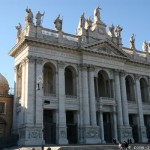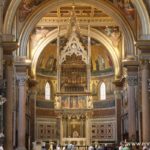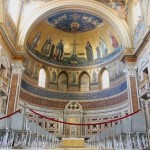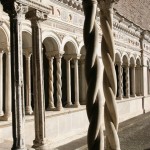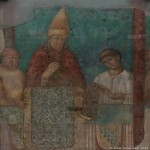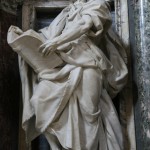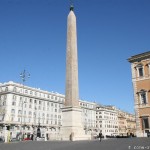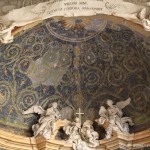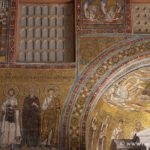In Italian: Basilica San Giovanni in Laterano
Renovated in the proportions of the original building, the Basilica of Saint John Lateran remains impressive and notably preserves a superb cloister that escaped the devastating fires of the 14th century. Dating back to 320 AD, it is the “mother of all churches” and the cathedral of Rome, housing the seat of the Bishop of Rome, who is the Pope himself—Saint Peter’s being the church of the Vatican. Inside, magnificent colossal statues of the apostles guide the visitor to the elegant ciborium. Near the church stands the beautiful octagonal Lateran Baptistery of early Christian origin, which retains original elements. The visit to Saint John Lateran ranks 11th in our Top 30 things to see in Rome.
Information and Hours for Saint John Lateran
These hours may vary, even temporarily, so it’s safer to check the official website for:
- Basilica San Giovanni in Laterano
Piazza di San Giovanni in Laterano
Hours
Basilica: open daily from 7:00 AM to 6:30 PM
Cloister: 9:00 AM to 6:00 PM (€2.00)
Basilica Museum: 10:00 AM – 5:30 PM - Lateran Baptistery
Piazza di San Giovanni in Laterano, 4
Daily from 7:00 AM to 12:30 PM and 4:00 PM to 7:00 PM - Scala Santa
Piazza di San Giovanni in Laterano, 14
Hours Monday to Saturday: 6:00 AM – 1:30 PM / 3:00 PM – 6:30 PM (October to March). Until 7:00 PM from April to September
Sundays and holidays: 7:00 AM – 1:30 PM / 3:00 PM – 6:30 PM (October to March). Until 7:00 PM from April to September
Papal Chapel Sancta Sanctorum: 9:30 AM – 12:40 PM and 3:00 PM – 5:10 PM (except Sundays and holidays), visit lasts about 20 minutes. Entry €3.50.
Suggested Tours of Saint John Lateran
Here are some suggestions for guided tours and entry tickets:
Visit and History of Saint John Lateran
The Cathedral Basilica of Rome
The church was rebuilt and embellished many times throughout history due to earthquakes, looting, or fires. From its original version, it primarily retains its proportions and general shape, as well as much of the nearby baptistery. It was Emperor Constantine who erected the first basilica here around 320 AD, making it the oldest of churches, the mother of all, which inspired and continues to inspire Christian buildings. Rebuilt by Nicholas IV at the end of the 13th century, it burned shortly after in 1308. Reconstructed and decorated by Giotto afterward, it was struck by another fire in 1360. In the mid-17th century, Innocent X entrusted its reconstruction to Francesco Borromini, who notably enhanced the interior with twelve niches housing the large statues of the apostles. The façade is more recent, dating to 1734, designed by the Florentine Alessandro Galilei, who won a contest—whose fairness is questionable—called by Pope Clement XII, also from Florence. The apse and its mosaics were fully renovated in the late 19th century.
The interior is 130 meters long. Several relics related to Christ are preserved there. A small fragment of Giotto’s fresco remains, depicting Boniface VIII at the Jubilee of 1300. The mosaics of the basilica’s apse, renovated in 1886, were inspired by the 13th century with a medieval narrative style. They feature imposing figures of Christ in majesty, surrounded by saints (Peter, Paul, John the Baptist) and the Virgin, in vivid shades of blue, red, and gold. They depict the heavenly triumph and the basilica’s role as the papal seat. Neoclassical details date from the 19th century.
Visiting Saint John Lateran is a beautiful experience in Rome, especially for the cloister, the ciborium, and the obelisk in the square.
Lateran Baptistery and Obelisk
Noteworthy are the very beautiful cloister and the nearby Lateran Baptistery, octagonal in shape, which has preserved fine early Christian remnants like the mosaics. These, dating from the 4th-5th centuries, are a jewel of early Christian art. They stand out for their simple and symbolic style, with geometric patterns like circles and crosses, and simple depictions of birds, vines, or fish, evoking eternal life and baptism. Their muted colors (greens, golds, whites) are typical of pre-Byzantine art. The mosaics in the atrium of the San Venanzio chapel depict scenes of salvation and faith.
On Lateran Square stands a tall Egyptian obelisk from the 15th century BC, originating from Karnak. At 36 meters, it is the tallest of the Egyptian obelisks.
Scala Santa and Sancta Sanctorum
The Scala Santa, the Holy Stairs, is located opposite the Lateran Palace and the Basilica of Saint John Lateran, across the avenue. It is housed in the Sancta Sanctorum church, originally a papal chapel, decorated by the Cosmati with 13th-century ornaments.
Resources for Further Exploration
- Official website: basilicasangiovanni.va
- The Basilica of Saint John Lateran on rome-roma.net, photos, history, and architecture; on Wikipedia
- Rome city portal: TurismoRoma 060608
How to Reach the Basilica and Map
On the eastern edge of the historic center, along the Aurelian Walls, the basilica can be reached in 20 minutes from the Colosseum. The metro Line A stops at the San Giovanni station, a 3-minute walk away. Many buses also pass through the area.
Address: Piazza di San Giovanni in Laterano, 4, 00184 Roma
If you see this after your page is loaded completely, leafletJS files are missing.
Selection of Accommodations Near Saint John Lateran
A selection of accommodations near the Basilica of Saint John Lateran, sorted by price and distance from the basilica, all among establishments rated as good (score above 8/10):
- Good hotels and accommodations sorted BY PRICE within 600 meters of the Lateran Basilica
- Good hotels and accommodations sorted BY DISTANCE from the basilica
Photo Gallery of the Basilica
- Facade
- Nave
- Nave of Saint John
- Ciborium
- Apse
- Cloister
- giotto fresco, Basilica of St. John Lateran
- Statue of Saint Matthieu
- Lateran Obelisk
- Lateran baptistery
- Lateran Baptistery
- Baptismal fountain
- Mosaic Chapel San Venanzio of the baptistery
Tips and FAQ for Visiting Saint John Lateran
How Much Time to Visit the Lateran Basilica and the Monuments in the Square?
Plan 1 to 1.5 hours to explore the basilica, cloister, and baptistery, and add 30 minutes if you visit the nearby Scala Santa. There is sometimes a line for the latter (especially during this Jubilee year of 2025), so consider arriving early (before 9:00 AM) if you wish to visit it.
Which Works of Art or Elements to See First?
- The colossal statues of the apostles along the basilica’s nave
- The Gothic ciborium and the apse mosaics
- The basilica’s cloister
- The Lateran Baptistery with its early Christian mosaics
- The Lateran Obelisk








